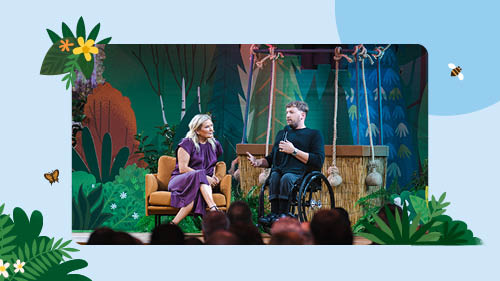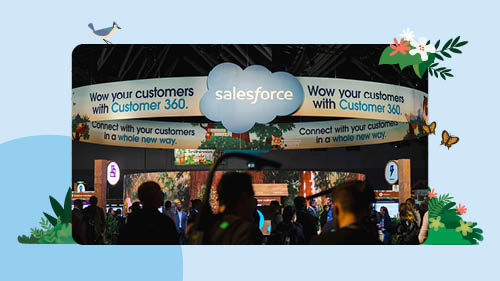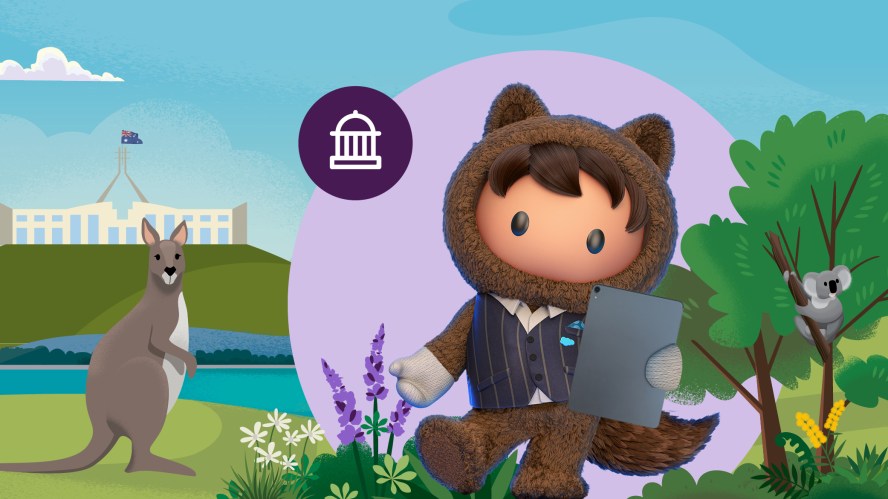6 rockstar public speakers share their tips



Public speaking can be daunting but it's a fantastic tool to engage and connect. Take a deep breath and get ready for your own mic drop moment.
Salesforce Staff
Does the thought of public speaking have you running for the hills? Or are you keen, but not sure you’re up to the task? Five of our most experienced speakers share the fears they’ve faced on stage, how they overcame them, and tips for nailing it.
Many of us will remember our first public speaking attempts from childhood – sweaty palm cards, trembling voice, eyes looking anywhere but at the audience of our classmates. Sure, some are naturals in front of a crowd. But for most of us, public speaking is torture at worst and, on an average day, a stomach-churning exercise in character development.
And yet, at its best public speaking can be thrilling and so rewarding. Sharing a message you feel strongly about is immensely satisfying and well worth the butterflies and sweaty palms. And the good news is, with a few tricks up your sleeve, those butterflies are toast – or at least not fluttering quite so frantically. With tips from some of Salesforce’s most experienced public speakers, this is now you can kill it on stage without dying inside.
The worst fears versus the not-so-bad reality
I’ll trip walking up to the podium. I’ll freeze. Everyone will laugh at me. My tech will fail. No one will get what I’m saying. My talk is silly.
K Yasas, Senior Director – Services, still gets anxious that the audience won’t be able to relate to the presentation. His strategy for overcoming that anxiety?
“Keep the messages simple and concise, and ask yourself what you’d like the key takeaways to be for anyone listening.” And for topics he’s unfamiliar with? “Ask a subject matter expert what is top of mind for them and use that as your basis for research.”

“Remember the session is about giving something of value to your audience,” says Vince Cotte, Director GTM Marketing APAC. “Think about it as contributing to a conversation – that’s not something to lie awake at night about. The talk track becomes more natural and authentic then too, and the narrative will be easier to remember.”
Easier said than done though, and no one is immune from the dreaded night-before-the-speech fears. We’ve all been there. But thinking about what might happen is usually the worst part. When things do go wrong it’s never the end of the world.
“Don’t be consumed with things that are very unlikely to happen and are probably out of your control,” Lee Hawksley, Senior VP and GM of Marketing Cloud, advises. “But have a plan to take them in your stride if they do.”
A mic fail, a slide out of order, a stumble over a tricky phrase – none of these constitutes a disaster.
“Nothing is ever perfect and I think one of the biggest skills of presenting is having the ability to work with what you have and be ready to improvise,” Jess O’Reilly, Regional VP for Marketing Cloud, Asia says. “Sometimes these are the best parts of presentations because you get the honest and vulnerable version of the presenter, not the rehearsed version – audiences really love those moments.”

And while forgetting lines used to be a worry for Megan Petersen, Director Trailhead Evangelism, she’s overcome that by being ready to improvise.
“The audience doesn’t know what you’re going to say,” Megan explains. “I spend more time coming up with ways to cope if there are technical glitches – like kicking off an audience karaoke session while the AV team sorts it out!”
Preparing for the worst
“I’ve had plenty of things go wrong,” says Jess. “But if you and your team have prepared for the ‘what if’ moment, then the show just goes on.” Practising with and trusting your team is a great way to be ready for any bumps.
“In my speech at the last World Tour, the demo didn’t work and we had to switch to a recorded version of it. But we’d prepared for that kind of hitch and the audience didn’t even notice,” Jess says.
One of the most common spanners in the works at a public speaking event is timing. “Schedule slippages mean your speaking slot gets adjusted and you end up with less time or more than you had prepared for,” explains Yasas. “Keep your prepared speech a little below the time allowed, and have a bit of extra content up your sleeve in case you need it.”
“There are always things outside your control,” says Derek Laney, Head of Solutions and Product Marketing, Asia Pacific. “One of the most common is having a guest suddenly drop out due to missed flights or illness. I recently had a speaker pull out of an event because they needed to travel unexpectedly for a religious commitment – anything in their personal lives can become more important than work and leave you stranded if you don’t have a plan B.”
Staying in close contact with your guests in the lead up to the presentation is the best way to make sure you’ll find out as early as possible if worst comes to worst.
“Send meeting invitations and make brief calls or send text messages to check in,” says Derek. “You can only do your best!”
Preparing for presenting alone, having a replacement waiting in the wings and even being ready to support your co-presenter are par for the course – because even when your speaker does make it to the stage on time, nothing is ever a sure bet.
“In my first ever keynote I was interviewing a very senior, confident person. But as soon as he got on stage, he just froze with nerves and didn’t know what to say,” Megan remembers. “I had been really nervous too, but funnily enough, his nerves dissolved my own. I knew I had to step up and take control of the situation to help him get through it. And in the end, we both rocked it.”

Vince has had everything go wrong at presentations that can, and he’s lived to tell the tale.
“Putting yourself into a foreign environment, often run by another company, will always throw up challenges,” he says. “So prepare well, know your material and be ready to deliver the presentation without AV if you have to.”
And if something does go wrong, and you haven’t had time to prepare for the worst?
“Whatever you do, don’t keep drawing attention to the issue or commentating on the problem,” advises Derek. “If the tech fails, you become the presentation. Tell stories, start a conversation with the audience.”
Megan advises thinking about whether anything is actually going wrong.
“Sometimes it can feel like something is wrong when you can’t get a read on the audience,” she says. “But different audiences respond in different ways. When I present in the US they applaud everything, speak up and interact, but Australian audiences tend to be a lot more reserved. So I’ve learnt not to ask too many open questions or make jokes and wait for laughter.”
The best parts
There are good parts to public speaking? You bet!
“The contrast between the nerves five minutes before you start and the euphoria five minutes after you start is amazing,” says Lee, whose standout public speaking moment was delivering a keynote at World Tour in Japan to launch Marketing Cloud. “It was a moment of great pride in our team and an honour for me to cap off their hard work. And I only had 48 hours’ notice!”

Then there’s the payback of knowing that you’ve connected with someone and shared something that’ll help them.
“There’s nothing better when you’re presenting than to see reactions from people in the audience,” says Jess. “A smile, a laugh, some tears, a nod of recognition – it’s incredibly rewarding.”
“It really is incredibly rewarding to know someone has been inspired by something you spoke about,” Megan agrees. “I’ve had people tell me recently that they saw me speak at an event and that it inspired them to get onto Trailhead and become a Ranger, or inspired them to make a change in their career. Having that kind of impact is an amazing feeling.”
A highlight for Yasas too is the opportunity to spread a good idea, share knowledge or build consensus and take a collective step forward. “I love receiving feedback – even if one person conveys they benefited from my presentation, it motivates me to do even better next time.”
For Vince, two months of preparation coming down to 10 minutes and 30 seconds on stage at World Tour Sydney last year was a thrill. And it was all done with a troll doll on his lapel – “a small homage to my children watching the live stream at home”.

Interviewing surfer Mick Fanning for Wellness Week was another highlight. “It was a total fanboy moment for me and a privilege to have the responsibility of drawing out his story for the audience,” Vince says.
For Derek Laney, it’s the thrill of the energy created by a live audience. “I find myself able to express so much more in a live format. There is something that changes in your brain when you prepare to deliver a presentation – it helps you seek clarity yourself before you communicate to others.”
Derek thrives on the drama of the unexpected and the unplanned.
“I loved hosting Salesforce’s 2018 Sydney World Tour Pitch Competition,” he says. “It was unscripted, with three amazing startups presenting and three celebrity guest judges asking them tough questions – and we were giving away a large monetary investment, so the stakes were high.”
At the end though, when scores were locked up and the judges started a pre-planned tie-breaker, the judges misinterpreted the scoring scale and the wrong team was announced as the winner. It was up to Derek to keep the energy high through multiple manual recounts of the scores.
“There was a huge crowd seated in the round watching and the tension caused me to go into high energy mode,” he recalls. “I put a big smile on my face and kept talking, while working through the steps in my head to resolve the situation. The audience was on the edge of their seats already!
Words of wisdom
- “The audience doesn’t want you to fail,” says Vince. “Indeed, the opposite is true. They want to see you succeed.”
- “Practice, practice, practice! But then be willing to improvise,” Jess recommends. “And just have fun with it.”
- “Be authentic,” says Megan. “Yes, there’s a script, but find a way to make it your own. I’m inspired by Leah McGowen Hare who has amazing passion and personality, and is always authentic.
- “Prepare, prepare, prepare. And then chill, chill, chill,” Lee says. “We’re just presenting, not saving lives.”
- “Try mapping your energy flow as part of your planning,” Derek suggests. “That way you can pace yourself well and avoid peaking too soon.”
- “Handling the fear of public speaking needs a belief that your audience are just everyday people, like you,” Yasas reminds us. “Put yourself in their shoes – what would you want to see and hear?”
Public speaking – not so terrible after all, right? In fact, it can be pretty fantastic. So take a deep breath and get ready for your own mic drop moment.
Skill up for the future
Build your skills so you’re ready to hit the stage with the Public Speaking Skills Trailhead module.






















